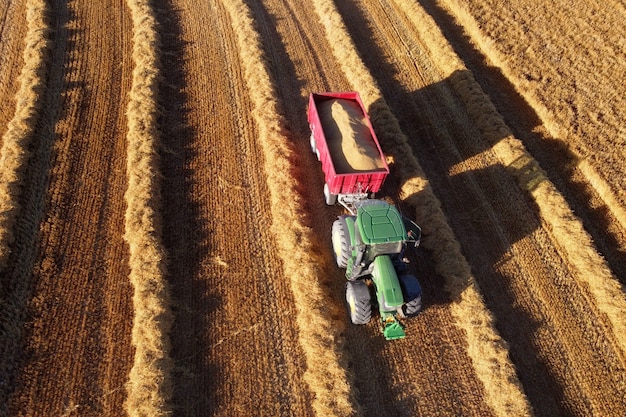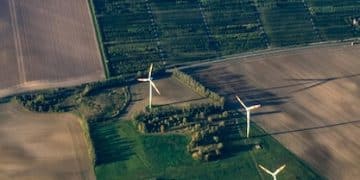Regenerative Agriculture: Can US Farms Sequester 1 Ton Carbon/Acre?

Regenerative agriculture offers US farms a promising path to enhance carbon sequestration, potentially reaching 1 ton per acre annually by implementing practices that improve soil health, boost biodiversity, and reduce reliance on synthetic inputs.
The urgent need to address climate change has driven significant interest in agricultural practices that not only produce food but also help mitigate greenhouse gas emissions. Regenerative agriculture: Can US farms increase carbon sequestration by 1 ton per acre annually? is being increasingly explored as a viable solution, promising to transform how we farm and manage our land.
What is Regenerative Agriculture?
Regenerative agriculture represents a holistic approach to farming and land management that aims to improve soil health, increase biodiversity, enhance water cycles, and, crucially, sequester carbon from the atmosphere. Unlike conventional farming methods that can degrade soil over time, regenerative practices focus on building soil organic matter and fostering a thriving ecosystem.
At its core, regenerative agriculture is about working with nature, rather than against it. It seeks to mimic natural processes to create resilient, productive, and self-sustaining farming systems. But what specific practices are involved, and how can they contribute to carbon sequestration? Let’s delve deeper.
Key Principles of Regenerative Agriculture
Several key principles guide regenerative agriculture, each contributing to its overall goals of soil health and carbon sequestration. Understanding these principles is essential for appreciating the potential of regenerative farming.
- Minimize Soil Disturbance: Reducing or eliminating tillage helps protect soil structure and prevents the release of stored carbon into the atmosphere.
- Maintain Soil Cover: Using cover crops, mulches, and other methods to keep the soil covered helps prevent erosion, suppress weeds, and enhance soil moisture retention.
- Promote Biodiversity: Integrating diverse plant and animal species into farming systems enhances soil health, improves nutrient cycling, and increases resilience to pests and diseases.
- Integrate Livestock: Managed grazing can improve soil fertility, stimulate plant growth, and enhance carbon sequestration.
These practices are not standalone solutions but rather interconnected components of a comprehensive regenerative farming system. By implementing these principles, farmers can create healthier soils that are better equipped to sequester carbon and support sustainable food production.
In summary, regenerative agriculture offers a transformative approach to farming that can improve soil health, increase biodiversity, and sequester carbon. By understanding and implementing its key principles, farmers can play a crucial role in mitigating climate change and creating more sustainable food systems.
The Role of Carbon Sequestration in US Farms
Carbon sequestration is the process of capturing and storing atmospheric carbon dioxide in plants, soils, and other natural reservoirs. US farms have a significant opportunity to contribute to this process through regenerative agricultural practices, helping to offset greenhouse gas emissions and mitigate climate change.
The potential for carbon sequestration on US farmland is substantial. According to recent studies, widespread adoption of regenerative practices could sequester millions of tons of carbon annually, making a significant contribution to national climate goals. But how exactly can US farms achieve this, and what are the potential benefits?

Benefits of Carbon Sequestration for US Farms
Carbon sequestration offers numerous benefits for US farms, beyond just mitigating climate change. These benefits can improve farm productivity, profitability, and resilience.
- Improved Soil Health: Sequestering carbon leads to increased soil organic matter, which improves soil structure, water retention, and nutrient availability.
- Enhanced Crop Yields: Healthier soils can support higher crop yields, leading to increased farm productivity and profitability.
- Reduced Input Costs: Regenerative practices can reduce the need for synthetic fertilizers, pesticides, and herbicides, lowering input costs and improving farm economics.
- Increased Resilience: Soils with high organic matter are more resilient to droughts, floods, and other extreme weather events, helping farms adapt to climate change.
These benefits highlight the potential of carbon sequestration to transform US farms into more sustainable and resilient enterprises. By adopting regenerative practices, farmers can improve their bottom line while also contributing to a healthier planet.
To conclude, carbon sequestration plays a critical role in mitigating climate change and enhancing the sustainability of US farms. By adopting regenerative practices, farmers can improve soil health, increase crop yields, reduce input costs, and build resilience to climate change.
Practices that Enhance Carbon Sequestration
Several regenerative agricultural practices are particularly effective at enhancing carbon sequestration. These practices focus on building soil health, increasing biodiversity, and reducing reliance on synthetic inputs.
Understanding these practices and how they contribute to carbon sequestration is essential for farmers looking to adopt regenerative farming methods. What are some of the most effective strategies, and how can they be implemented on US farms?
No-Till Farming
No-till farming involves eliminating or minimizing tillage, which helps protect soil structure and prevent the release of stored carbon into the atmosphere. It also improves water infiltration and reduces soil erosion.
By reducing soil disturbance, no-till farming allows organic matter to accumulate, increasing soil carbon levels. This practice is widely recognized as a key component of regenerative agriculture.
Cover Cropping
Cover cropping involves planting crops specifically to cover the soil, rather than for harvest. Cover crops help prevent erosion, suppress weeds, and enhance soil moisture retention. They also add organic matter to the soil, increasing carbon sequestration.
Different cover crop species offer different benefits, allowing farmers to tailor their cover cropping strategies to specific soil types and climate conditions.
Crop Rotation
Crop rotation involves planting different crops in a planned sequence, which can improve soil health, reduce pest and disease pressure, and enhance nutrient cycling. Crop rotation can also increase carbon sequestration by diversifying soil inputs and outputs.
By rotating crops with different rooting depths and nutrient requirements, farmers can create a more balanced and resilient soil ecosystem.

Managed Grazing
Managed grazing involves carefully controlling the timing, intensity, and duration of livestock grazing, which can improve soil fertility, stimulate plant growth, and enhance carbon sequestration. Managed grazing can also promote biodiversity and reduce the need for synthetic fertilizers.
By allowing livestock to graze in a controlled manner, farmers can mimic natural grazing patterns and create a more sustainable and resilient grazing system.
In conclusion, no-till farming, cover cropping, crop rotation, and managed grazing are all effective practices for enhancing carbon sequestration on US farms. By implementing these strategies, farmers can improve soil health, increase biodiversity, and contribute to mitigating climate change.
Economic Incentives for Regenerative Agriculture
While the environmental benefits of regenerative agriculture are clear, economic incentives play a crucial role in encouraging widespread adoption. These incentives can help offset the initial costs of transitioning to regenerative practices and provide ongoing support for farmers.
What financial mechanisms and programs are available to support regenerative agriculture in the US? How can these incentives be structured to maximize their impact and ensure long-term sustainability?
Government Programs
Several government programs offer financial and technical assistance to farmers who adopt regenerative practices. These programs can provide cost-share funding, technical guidance, and other forms of support.
- Environmental Quality Incentives Program (EQIP): Provides financial and technical assistance to farmers who implement conservation practices, including regenerative agriculture.
- Conservation Stewardship Program (CSP): Rewards farmers who actively manage and improve conservation practices on their land.
- Sustainable Agriculture Research and Education (SARE): Supports research and education projects focused on sustainable and regenerative agriculture.
These programs represent a significant investment in regenerative agriculture and can help farmers overcome the financial barriers to adoption.
Carbon Markets
Carbon markets offer farmers the opportunity to earn revenue by sequestering carbon in their soils. These markets allow companies and individuals to purchase carbon credits from farmers who implement regenerative practices.
While carbon markets are still relatively new, they have the potential to provide a significant source of income for farmers who adopt regenerative agriculture.
Private Investments
Private companies and organizations are increasingly investing in regenerative agriculture, recognizing its potential to improve soil health, enhance biodiversity, and mitigate climate change. These investments can take the form of direct funding, technical assistance, or partnerships with farmers.
Private investments can help scale up regenerative agriculture and accelerate its adoption across the US.
In summary, government programs, carbon markets, and private investments all play a crucial role in providing economic incentives for regenerative agriculture. By leveraging these incentives, we can significantly enhance carbon sequestration.
Challenges and Barriers to Adoption
Despite the numerous benefits of regenerative agriculture, several challenges and barriers can hinder its widespread adoption. Addressing these challenges is essential for realizing the full potential of regenerative farming.
What are some of the key obstacles that farmers face when transitioning to regenerative practices? How can we overcome these barriers to encourage more widespread adoption of regenerative agriculture?
Lack of Knowledge and Technical Expertise
Many farmers lack the knowledge and technical expertise needed to successfully implement regenerative practices. This can be a significant barrier to adoption, particularly for farmers who are unfamiliar with these methods.
Providing farmers with access to training, technical assistance, and peer-to-peer learning opportunities can help overcome this barrier.
Initial Costs and Transition Period
Transitioning to regenerative agriculture can involve significant initial costs, such as purchasing new equipment, planting cover crops, and implementing new management practices. It can also take several years to see the full benefits of regenerative farming, which can be a disincentive for some farmers.
Providing financial assistance, such as cost-share funding and low-interest loans, can help offset these initial costs and encourage farmers to make the transition.
Market Access and Consumer Demand
Despite growing interest in sustainably produced food, market access and consumer demand for regenerative agriculture products are still limited. This can make it difficult for farmers to sell their products at a premium and recoup the costs of implementing regenerative practices.
Increasing consumer awareness of the benefits of regenerative agriculture and developing market channels that connect farmers with consumers can help address this challenge.
Policy and Regulatory Frameworks
Existing policy and regulatory frameworks may not adequately support regenerative agriculture, which can create barriers to adoption. Reforming these frameworks to better align with the principles of regenerative agriculture can help create a more supportive environment for farmers.
In conclusion, a lack of knowledge and technical expertise, high initial costs and transition periods, limited market access and consumer demand, and unsupportive policy frameworks all pose challenges to the adoption of regenerative agriculture. By addressing these challenges, we can create a more favorable environment for farmers.
Future of Regenerative Agriculture in the US
The future of regenerative agriculture in the US looks promising, with growing recognition of its potential to improve soil health, increase biodiversity, and mitigate climate change. As more farmers, policymakers, and consumers embrace regenerative practices, we can expect to see significant growth in this sector.
What are some of the key trends and developments that will shape the future of regenerative agriculture in the US? How can we accelerate its adoption and maximize its impact?
- Technological Advances: New technologies, such as precision agriculture and remote sensing, can help farmers better manage their regenerative practices and optimize carbon sequestration.
- Policy Support: Increased government support for regenerative agriculture can help incentivize adoption and create a more level playing field for farmers.
- Consumer Awareness: Growing consumer awareness of the benefits of regenerative agriculture can drive demand for sustainably produced food and create new market opportunities for farmers.
- Collaboration and Partnerships: Collaboration and partnerships between farmers, researchers, policymakers, and consumers can help accelerate the adoption of regenerative agriculture and maximize its impact.
These trends and developments suggest that regenerative agriculture has the potential to transform US farming and contribute to a more sustainable and resilient food system.
In summary, the technological advances, policy support, increased consumer awareness, and collaboration are shaping the expansion of regenerative agriculture in US. US farms can truly increase carbon sequestration by 1 ton per acre annually through regenerative agriculture if the right approach is employed.
| Key Point | Brief Description |
|---|---|
| 🌱 Soil Health | Regenerative practices enhance soil structure and fertility. |
| 🚜 Carbon Sequestration | Farms can sequester 1 ton of carbon per acre annually. |
| 💰 Economic Incentives | Government programs and carbon markets support adoption. |
| 🌍 Climate Change | Regenerative agriculture helps mitigate climate change impacts. |
Frequently Asked Questions (FAQ)
▼
Regenerative agriculture is a holistic approach to farming that focuses on improving soil health, increasing biodiversity, enhancing water cycles, and sequestering carbon, aiming to create sustainable farming systems.
▼
With practices like no-till farming, cover cropping, crop rotation, and managed grazing, US farms can improve carbon sequestration and potentially achieve the target of one ton per acre annually.
▼
Financial assistance from government programs, carbon markets, and private investments can help with transition costs, making regenerative agriculture a viable option.
▼
Farmers face barriers like a lack of knowledge, high upfront costs, market access, and policy support. Overcoming these challenges will facilitate broader adoption of regenerative agriculture.
▼
With technology, increased policy backing, a rise in consumer interest, and stronger collaborations, regenerative agriculture is set to transform US farming practices and contribute to climate solutions.
Conclusion
Regenerative agriculture represents a promising pathway for US farms to improve soil health, enhance biodiversity, and contribute to climate change mitigation. By adopting regenerative practices and overcoming the challenges to adoption, US farms can improve carbon sequestration and transform US farming.





